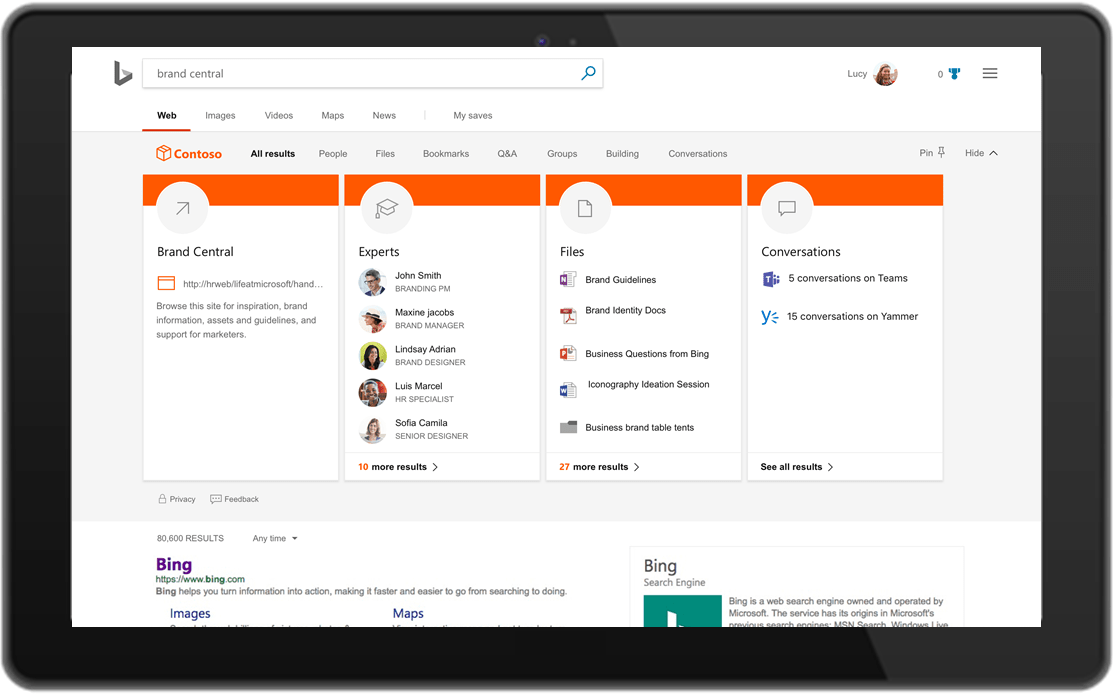

2018/11/17 Microsoft Cloud Solutions 2561 visit(s) 3 min to read
Ctelecoms

At Ignite last year, Microsoft introduced personalized search across Office 365, a way to bring intelligent search and discovery experiences directly to you. Today Microsoft announced that they’re expanding that vision to encompass search both inside and outside of Microsoft 365. By applying artificial intelligence (AI) technology from Bing to the deep personalized insights surfaced by the Microsoft Graph, Microsoft has successfully managed to make search in your organization even more effective.
With Microsoft Search, you will enjoy organizational search experiences into the apps you use every day, including Bing.com and Windows, and the ability to connect across your organization’s network of data.
Microsoft has also evolved the notion of what search means. Getting pages of results with hyperlinks to other information is simply not enough. Faced with ever decreasing attention spans, and an explosion of data, Microsoft recognizes that the challenge is to find and deliver answers to your questions, suggest insights, and enable you to take action on your tasks. This makes search a powerful capability that stretches across your work to make you more productive and take advantage of the collective knowledge from your organization.
The goal is a cohesive and coherent search capability, prominent in every experience, providing the way to search across all your organization’s data—both inside and outside of Microsoft 365.
Key to delivering the Microsoft Search capability is the ability to have consistent scope of results anywhere you are searching. Even if the interface looks different, the goal is to have the same experience, personalized and contextualized for that specific interaction point.
Microsoft has recently introduced the ability to search across conversations in both Teams and Yammer simultaneously.

Searching in Bing returns both your organizational results and web results, making it an easy destination for broad searches to get the best of your work world and secure your web searches. Public preview begins rolling out today. Tenant admins must opt in to the experience for their organization.
Get back to your work faster with Office.com, surfacing the same search scope across Microsoft 365. Find documents you were recently working on, as well as recommended documents that your colleagues have mentioned you in, and keep up to date with what has been worked on since you last looked at it. Microsoft Search in Office.com goes into targeted release today.

The new version of the SharePoint mobile app includes search as the default experience when you enter the app. It lists common questions, personalized results, and frequent searches that organizations can curate. The new SharePoint mobile app is available for download today.

The Outlook mobile app also highlights search as an important element of the user experience, providing access to commands, content, and people. With “zero query search,” simply placing your cursor in the search box will bring up recommendations powered by AI and the Microsoft Graph. The Outlook mobile app for iOS and Android are available for download today.
Outlook will also bring zero query, fuzzy search, and top results based on intelligent technology to other endpoints as we drive towards coherence. Enhancements to search in Outlook for Windows, Mac, and on the web started to roll out to targeted release mid-September.
Microsoft’s new suite-wide search in the ribbon offers the same consistent experience and results across your favorite Office apps—

Right from your taskbar, perform searches that include local and organizational search results; whether that is people, the location of an office, or your files, you can find it all in Windows.

The Microsoft Graph gleans insight from the people, sites, devices, and documents you work with and is the basis for consistent learning across your organization, wherever you and your colleagues work. Microsoft Graph ranks search results relevant to your needs. You can see all the results that satisfy your query, but personalized search prioritizes the results that are most likely to achieve your objective.
Supercharging the Microsoft Graph with advanced AI technology from Bing and its knowledge of the world, Microsoft can extend its vision for insightful technology to make it simple to ask natural language questions and get real answers, without manual intervention. For example, a question such as “Can my brother work for me at my company?” means that not only syntactic parsing of the question is necessary but semantic understanding. Your organization’s HR policy probably specifies “close family relationships,” so Microsoft uses Bing’s knowledge of the world to expand and match “brother” and couple that with searching your organization’s intranet to derive the answer.
Using this machine reading comprehension technology is just one of the many ways Microsoft will be continuously improving Microsoft Search in the future.
Original Blog by: Jeff Teper, Corporate Vice President for OneDrive, SharePoint, and Office, on September 24, 2018
Ctelecoms Teams